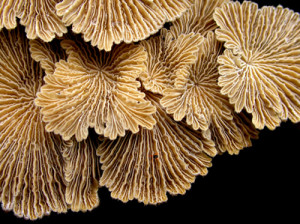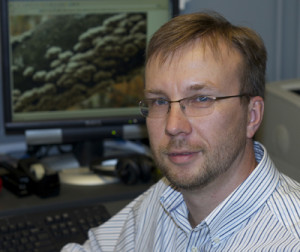WALNUT CREEK, CA—One of the challenges in making cellulosic biofuels commercially viable is to cost-effectively deconstruct plant material to liberate fermentable energy-rich sugars. The U.S. Department of Energy (DOE) is funding several projects focused on identifying enzymes in organisms that optimally degrade cellulosic feedstocks. One such source are fungi, which break down dead wood and leaf litter in forests; in fact, some pest management companies consider wood rot more destructive for homes than termites.
The DOE Joint Genome Institute (JGI) previously sequenced and published the genomes of two wood-decaying fungi. Now a team of researchers led by scientists from the DOE JGI and the University of Utrecht announce the analysis of a third such genome in a study published online July 11 in Nature Biotechnology. All told, DOE JGI has sequenced and annotated 40 fungal genomes, and 40 more are currently in the works.
“When we go into a forest we don’t see layers of dead branches because wood decay fungi take care of them,” said Igor Grigoriev, head of the DOE JGI’s Fungal Genomics Program and a senior author on the study. “So when we think about bioenergy and degrading biomass and converting that into biofuel, we would like to learn the most efficient ways of doing that from fungi, which have invented many ways of doing that in nature. Schizophyllum commune is the second white rot fungus and third wood degrader we’ve sequenced. The DOE JGI sequenced the first white rot fungal genome — Phanerochaete chrysosporium — in 2004. Then last year we sequenced the first brown rot fungal genome – Postia placenta.” Postia was found to utilize a unique arsenal of small oxidizing agents that blast through plant cell walls to decompose cellulose into simple sugars.
Found on every continent except Antarctica, S. commune is characteristic of other white rot fungi. S. commune breaks down cellulose and lignin by invading xylem tissue, and researchers hope that studying its 38.5 million nucleotide genome (containing about 13,200 genes) will help them harness the most relevant set of enzymes for specific biofuel production strategies. White rot fungi also have potential bioremediation applications as they have enzymes that can break down contaminants such as uranium and heavy metals.
“The surprise we saw is how significantly larger is the variety of enzymes in S. commune that are involved in plant biomass degradation compared to P. chrysosporium,” Grigoriev said. “In fact, S. commune has among the most extensive enzymatic machinery for degrading cellulose, hemicellulose, and lignin of the fungi we examined.”
One additional advantage to using S. commune, said study senior author Han Wosten, a microbiologist at the University of Utrecht who is studying S. commune’s mushroom-forming capabilities, is that the fungus can be easily grown in the lab. Additionally, he said, researchers can inactivate the genes in S. commune by deleting them. “This is the only mushroom-forming fungus in which gene deletions have been made,” he said, “allowing us to study the roles of genes in wood degradation and mushroom formation.” Wosten also suggested that there are opportunities for inserting genes and modulating expression levels to drive target protein production pathways.
Grigoriev said the DOE JGI is in the process of sequencing over a dozen more wood-decaying fungi. According to the Genomes OnLine Database (GOLD) the DOE JGI is responsible for more than a third of all fungal genomes sequenced or in the queue to be sequenced worldwide, and with two white-rot fungi and a brown-rot fungus done, he added, “we think we’re only touching the surface and we need to look at more genomes in order to understand the whole scope of diversity and mechanisms applied to degrading cellulose.”
Other DOE JGI authors on the paper are Andrea Aerts, Scott Baker (Pacific Northwest National Laboratory), Erika Lindquist, Susan Lucas, Asaf Salamov, and Jeremy Schmutz (HudsonAlpha Institute for Biotechnology).
The U.S. Department of Energy Joint Genome Institute, supported by DOE’s Office of Science, is committed to advancing genomics in support of DOE missions related to clean energy generation and environmental characterization and cleanup. DOE JGI, headquartered in Walnut Creek, Calif., provides integrated high-throughput sequencing and computational analysis that enable systems-based scientific approaches to these challenges. Follow DOE JGI on Twitter and Facebook.

